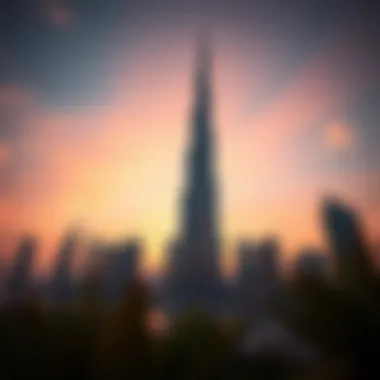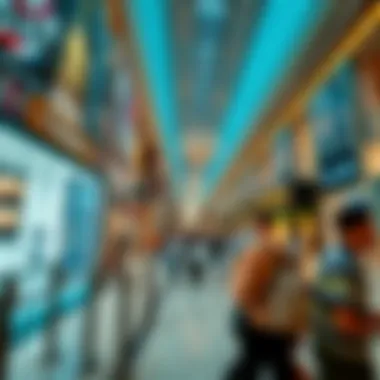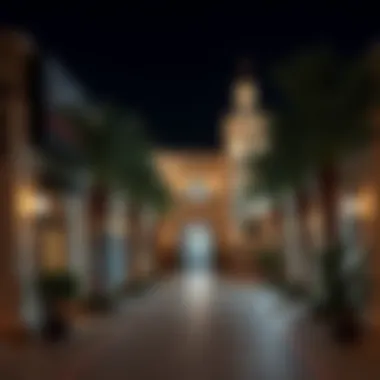Discovering Key Tourist Destinations in Dubai


Intro
Dubai has come a long way from its humble beginnings as a small fishing village to becoming a dazzling metropolis, often seen as a playground for the rich and famous. The skyline today is dominated by remarkable structures that defy the laws of architecture and elevate the standards of luxury living. But beyond the eye-catching buildings, Dubai offers a smorgasbord of experiences that blend the modern with the traditional. The numerous tourist attractions shape not only the tourism landscape but also the real estate sector, making it essential to comprehend their interconnections.
Visitors often perceive Dubai as an oasis of opulence, with spots like the Burj Khalifa, the world’s tallest building, leading the charge. Yet, it’s not just the iconic structures that capture the imagination; cultural experiences, such as the historic Al Fahidi District or the tranquil charms of the Dubai Creek, play a significant role in what makes the city appealing. Investors take note: understanding these attractions and their contextual importance can greatly influence investment decisions.
This article delves into the significant tourist attractions, examining their allure and impact on the real estate market. As we navigate through this exploration, we will shed light on market trends, investment opportunities, and how the vibrant tourism sector shapes the dynamics of property ownership in Dubai. So buckle up as we embark on this informative journey through a city where each landmark tells a story of ambition, innovation, and the pursuit of luxury.
Overview of Dubai's Tourism Landscape
Dubai stands as a shining beacon of tourism in the Middle East, attracting visitors from all corners of the globe. This city’s ability to fuse ultramodern architecture with rich cultural traditions is a unique trait. The tourism landscape here fosters not just leisure activities for visitors but also significantly impacts the economic fabric of the region.
Importance of Tourism in Dubai's Economy
Tourism in Dubai is more than just a buzzword. It directly contributes to the national income, providing thousands of jobs across various sectors. From hotel management to retail, the ripple effect of tourism reaches far and wide. The sector attracted about 17 million visitors in 2019, marking a steady climb in recent years which underscores its pivotal role. The government backs tourism through substantial investments in infrastructure and marketing campaigns. Without the influx of tourists, many other sectors would struggle to thrive.
More specifically, tourism accounts for an estimated 11% of Dubai's GDP, a figure that speaks volumes about its importance. Businesses relating to travel, hospitality, and entertainment gear their operations toward maximizing the tourist experience. Moreover, the growth of mega events like Expo 2020 has further amplified Dubai's global appeal, drawing even more international attention and investment to the area.
Current Trends in Dubai Tourism
As the world continues to evolve, so does the tourism scene in Dubai. One sees several trends shaping the industry today. For instance, there's a notable shift toward experiential travel; tourists are opting for hands-on experiences rather than passive sightseeing. This has led to an increase in demand for cultural and adventure-themed activities.
Furthermore, the surge in digitalization has facilitated a new wave of convenience for travelers. Booking accommodations and planning itineraries has never been easier, allowing prospective visitors to tailor their experiences based on preferences and interests. Social media also plays a crucial role, with influencers showcasing less-known gems of the city, enhancing interest in authentic experiences away from the regular tourist traps.
Sustainable tourism is increasingly coming into play as well. Visitors now seek greener alternatives, prompting local businesses to adopt environmentally friendly practices. To support this, the government has initiated several sustainability programs aimed at making Dubai a leader in eco-tourism.
In essence, the tourism landscape of Dubai isn't static; it evolves with changing societal norms and expectations. For potential investors, understanding these trends is critical not just for capitalizing on opportunities, but also for contributing positively to the local economy.
“The future of tourism in Dubai will be shaped not only by travel trends but also by the adaptability of businesses to meet the changing demands of a global market.”
Architectural Marvels
Architectural marvels form the backbone of Dubai's skyline, making it a beacon of modern engineering and design. Each structure not only serves a functional purpose but also tells a story of innovation, luxury, and ambition. By exploring these marvels, one gains insight into the cultural and economic dimensions that drive Dubai's tourism industry. The allure of these iconic sites often translates into increased property value and global interest, offering numerous investment opportunities.
Burj Khalifa: The Iconic Skyscraper
Standing tall at 828 meters, the Burj Khalifa is not just a skyscraper but a symbol of what Dubai represents. This architectural giant draws millions of visitors every year who seek an unforgettable experience from its observation decks, where one can see the city stretch beyond the horizon. The building incorporates state-of-the-art design and technologies, from energy-efficient materials to innovative AR systems, which provide visitors with an interactive experience.
Interestingly, the Burj Khalifa is more than just a place to snap photos. It acts as a catalyst for tourism in the surrounding areas, leading to the development of additional attractions such as the Dubai Fountain and Dubai Mall. Properties in close proximity to this tower have seen an uptick in value, making it a prime focus for investors looking to capitalize on the popularity of this landmark.
The Palm Jumeirah: A Man-Made Wonder
The Palm Jumeirah, often described as one of the wonders of modern engineering, is a testament to human creativity and ambition. Shaped like a palm tree, this artificial archipelago houses luxurious hotels, such as the famous Atlantis, The Palm, and high-end residences that attract wealthy expatriates and investors alike. From the air, it resembles a fantastical island paradise, perfectly reflecting the opulence associated with Dubai.
By constructing this unique attraction, Dubai further cemented its status as a premier global tourist destination. The Palm offers various activities, from sunbathing on pristine beaches to dining in world-class restaurants, enhancing the overall experience for visitors. The ongoing development and evolution of properties on this island highlight its significance in the real estate market, drawing keen interest from international investors.


Burj Al Arab: A Symbol of Luxury
Often referred to as the "World's Only 7-Star Hotel," the Burj Al Arab embodies the lavish lifestyle Dubai is known for. This sail-shaped structure soars high above the Arabian Gulf and is an intricate blend of luxury, style, and design. Guests seeking unparalleled services and exclusive experiences flock to this hotel, making it a must-visit site for travelers.
Additionally, the Burj Al Arab's impact on the local economy is notable. It attracts wealth and tourism unlike any other venue, significantly contributing to the surrounding area's property growth. Real estate adjacent to the hotel has escalated in value, shedding light on how luxury and tourism intertwine in Dubai's unique market.
The architectural landscape of Dubai showcases the synergy between tourism and real estate, serving as a pivotal part of the city's economic strategy.
Cultural Heritage Sites
Cultural Heritage Sites play a crucial role in shaping the unique identity of Dubai. They offer a window into the past, showcasing the traditions and stories that have influenced the city's evolution. For investors and visitors alike, these sites present more than just a nostalgic glance; they provide insight into the cultural fabric, enhance community pride, and maintain connections among generations. Furthermore, understanding these heritage sites can help one gauge the potential of related real estate opportunities, especially in terms of tourism-related developments.
Investors should consider these aspects before entering the market:
- Heritage Impact: Properties near these sites often appreciate in value due to increased tourist footfall.
- Cultural Events: Many heritage sites host events that draw crowds, benefiting local businesses.
- Community Engagement: Investing in areas that celebrate their cultural heritage fosters a sense of identity, thereby enhancing property desirability.
Dubai Museum: A Glimpse into History
Located in Al Fahidi Fort, the Dubai Museum stands as a testament to the city’s rich historical background. Established in 1971, it tells the story of Dubai from its humble beginnings as a fishing village to its rise as a global metropolis. The museum houses an impressive collection of artifacts, ranging from ancient pottery to traditional Emirati attire, showcasing how trade and culture have shaped the emirate.
Visitors can explore recreated scenes of life in Dubai before the oil boom, which highlights the innovative methods the people employed to thrive in a desert environment. This contextual understanding is invaluable not only for tourists seeking depth in their experiences but also for investors looking to tap into the burgeoning interest in heritage tourism.
As the museum continually evolves, featuring traveling exhibitions and interactive installations, it keeps the spirit of the past alive while educating future generations. A visit to the museum is a must for someone keen on understanding Dubai's journey.
"The museum is a beacon of cultural preservation, holding stories that are vital to Dubai's identity."
Al Fahidi Historical Neighborhood: A Cultural Journey
Al Fahidi Historical Neighborhood, often referred to as Bastakiya, is where the past tangibly mingles with the present. The narrow lanes, wind towers, and intricately designed courtyard houses reflect the architectural style of early 20th-century Persia and the UAE’s rich trading history.
Walking through this area is akin to stepping back in time. The neighborhood is dotted with art galleries, cafes, and cultural institutions, inviting visitors to immerse themselves in the local art scene and traditional crafts like weaving and pottery-making. The Dubai Creek, which flows nearby, was a lifeline for the residents, acting as a conduit for trade and cultural exchange.
For real estate investors, Al Fahidi offers a unique proposition. Properties here range from beautifully restored heritage homes to modern architectural marvels. The growing interest in maintaining cultural integrity while also catering to contemporary tastes makes this area a hot spot for potential investments. Visitors of this neighborhood benefit from a serene yet culturally rich environment that often contrasts sharply with the bustling modern city.
In summary, Cultural Heritage Sites in Dubai like the Dubai Museum and Al Fahidi Neighborhood are not just reflections of history; they are vibrant spaces that open doors to investment opportunities and unique experiences. They tell a story that not only shapes the character of Dubai but also its economic landscapes.
Entertainment and Leisure Options
The array of entertainment and leisure options in Dubai stands as a vital part of the city's appealing allure. Not only does this sector entice millions of tourists every year, it also contributes significantly to the local economy and influences real estate trends. Attraction-driven investments are highly sought after in this bustling metropolis. Similar to a moth drawn to a flame, tourists flock to these havens of enjoyment, shopping, and culture, driving up property values in nearby areas and catalyzing growth for new developments. The intricacies of such options extend beyond mere fun; they forge connections among people and stimulate diverse industries.
Dubai Mall: Shopping and Beyond
In Dubai, if one mentions shopping, the Dubai Mall is likely the first to pop to mind—rightly so. As one of the largest shopping centers in the world, this behemoth spans over 1 million square meters. It's more than just a retail paradise; it's an experience, offering over 1,200 shops, dozens of dining options, and a host of entertainment features. Visitors can cherish unique attractions like an indoor aquarium complete with sharks and a virtual reality park that whisks you into fantastical realms.
However, the mall’s significance isn't limited to consumerism. It serves as a social nexus, drawing in crowds from all walks of life and facilitating a blend of cultures. Therefore, anyone eyeing investment opportunities should recognize how the proximity to this landmark can elevate property values. Living or operating a business within a stone’s throw of the Dubai Mall can translate to a major financial boost.


- Key Features of Dubai Mall:
- Over 1,200 retail outlets
- Indoor ice skating rink
- Enormous aquarium and underwater zoo
- Dubai Fountain, the world’s largest choreographed fountain system
- Screening of blockbuster films at a state-of-the-art cinema
The vibrancy of Dubai Mall illustrates how leisure activities tie into the fabric of urban life and residential opportunities.
Global Village: A Cultural Extravaganza
Global Village stands as a testament to Dubai's global outlook and rich diversity. This outdoor theme park showcases the cultures of over 90 countries, which makes it a local favorite and a must-see for tourists. Each pavilion presents unique crafts, culinary delights, and cultural performances. Visitors feel the pulse of international traditions in every corner, from taste-testing food from countries across the globe to soaking in artistic presentations that reflect the essence of various cultures.
- Cultural Showcases Include:
- International culinary experiences
- Traditional performances from different countries
- Handicraft exhibits and shopping
Furthermore, Global Village serves as an incubator for small businesses and craftsmen, giving local talents a platform to shine. Investors exploring real estate opportunities may find strategic value in areas surrounding Global Village as they increasingly serve as hot spots for communal gatherings, setting the stage for future developments. Actually, neighborhoods near such attractions often flourish, creating appealing choices for expatriates and homeowners alike.
"Dubai’s entertainment hubs create not just amusement but also economic avenues for property investors. The symbiosis between leisure and real estate is undeniable, as attractions drive footfall, leading to higher demand for housing."
In summary, the entertainment and leisure options in Dubai are not just there for enjoyment; they lay the groundwork for significant economic impact and investment potential. Engaging with these hotspots can thus provide one with a solid foothold in this rapidly evolving city.
Natural Attractions
Natural attractions in Dubai hold a special place in the tourism landscape of the city. These scenic escapes offer a contrast to the urban chaos, providing visitors and residents alike an opportunity to reconnect with nature. From rolling sand dunes to serene waters, these attractions are not just leisure spots, but pivotal elements that shape the city's identity and appeal.
Desert Safaris: Adventurous Getaways
Desert safaris represent a quintessentially Dubai experience, drawing in both thrill-seekers and those looking to understand the city’s unique environment. These excursions often start with a drive into the vast desert surrounding the city, where the golden sands stretch for miles. Visitors can enjoy activities like dune bashing, sandboarding, or camel riding, giving them an adrenaline rush and a chance to witness the stunning landscape firsthand.
"When you’re out there in the desert, it feels like you’ve stepped into another world. The quiet beauty of the dunes is simply breathtaking."
Benefits of Desert Safaris:
- Cultural Exposure: Many tours combine adventure with a taste of Emirati culture. They often include traditional meals, dance performances, and cultural displays in Bedouin-style camps.
- Photography Opportunities: The shifting sands during sunset provide excellent photo ops. Capturing the play of light on the dunes is a reward in itself.
- Connection with Nature: In contrast to Dubai’s urban setting, the expansive desert gives a sense of peace and solitude, making it a perfect getaway from the hustle and bustle.
Planning a desert safari can be as straightforward as booking with a reputable tour operator, ensuring safety and a comprehensive experience.
Dubai Creek: The Heart of the City
Dubai Creek is not just a waterway; it's the lifeblood of the city, reflecting its maritime heritage and trade history. This natural inlet divides the city into two sections: Deira and Bur Dubai, creating a unique blend of old and new.
Stroll along the banks, and one can see the juxtaposition of traditional abras (small wooden boats) ferrying passengers alongside modern yachts. The Creek is lined with markets, cafes, and historically significant sites like the Dubai Museum and the Gold Souk, making it a vibrant area that encapsulates the essence of Dubai.
Key Features of Dubai Creek:
- Cultural Significance: The creek is steeped in history, as it was once the center of trade and fishing, forming the foundation of Dubai's economy.
- Leisure Activities: Visitors can enjoy dhows that offer dinner cruises, providing a unique view of the city skyline lit up at night.
- Environmental Importance: The Creek is home to diverse marine life, helping to promote eco-tourism and conservation efforts in the city.
In sum, the natural attractions of Dubai, from the breathtaking desert landscapes to the historically significant Dubai Creek, offer enriching experiences that resonate with both tourists and locals alike. These sites underscore the city’s innovative spirit while still embracing its natural heritage. For potential investors and residents, understanding these features can provide valuable insight into areas that are not only recreational but also represent an essential part of Dubai's cultural and economic framework.
Impact on Real Estate Development


Real estate development in Dubai owes much of its growth and vitality to the city’s booming tourism sector. As tourist numbers continue to swell, the demand for properties—be they residential, commercial, or hospitality—inevitably follows. The symbiotic relationship between tourist attractions and the real estate market is notably significant. Developers, investors, and residents alike need to grasp how these attractions influence property dynamics to make informed decisions.
Tourist attractions have a profound impact on property values. As places like the Burj Khalifa or The Palm Jumeirah draw millions of visitors, they also attract potential homeowners and investors. Properties located in proximity to these landmarks often see an uptick in value due to increased demand. For instance, real estate agents often note higher selling prices for apartments with views of icon structures or those situated near vibrant shopping hotspots like Dubai Mall.
The desirability of a location directly correlates to its accessibility and appeal to tourists. When prospective buyers perceive an area as a tourist hub, they tend to associate it with a lively atmosphere, potential for rental income, and long-term capital appreciation. Therefore, an understanding of how tourism feeds into the valuation of properties is crucial for anyone delving into Dubai’s real estate scene.
Moreover, property development that hinges on tourism often results in strategically planned communities and mixed-use developments. These projects are designed not only with residents in mind but also cater to the experience of visitors, offering—
- Hotels and resorts
- Retail spaces
- Entertainment options
This holistic approach enhances the overall allure of a neighborhood, making it a double win for developers and investors—greater footfall generates economic viability and elevated living standards.
“The place you invest could either be your fortress or a plain old shack; it's all in how close it is to action.”
Tourism and Property Value Trends
The trends relating to tourism's influence on property values reveal a significant narrative. In recent years, areas that have been traditionally less popular have transformed dramatically. Consider Dubai Marina—once a ripple in the city’s vast sea of opportunity, now stands as a sought-after destination. The influx of tourists seeking memorable experiences augmented property prices in this locale.
The fluctuations in property values driven by tourism can be analyzed in phases:
- High Demand Periods: Events like the Dubai Shopping Festival or Expo 2020 create spikes in tourist arrival, subsequently boosting rental prices and property valuations.
- Post-Event Lull: Following large-scale events, while property values might take a slight dip, the long-term image of the area often remains intact, thanks to the lasting infrastructure developments and tourist interest that these events leave behind.
- Ongoing Developments: Continuous investment in attractions reinforces the importance of monitoring ongoing tourism projects. If a new theme park or cultural site is announced, property trends in nearby locales often reflect potential upswings in value.
All of this means that for potential investors or buyers, timing and location are everything. An astute eye for emerging hotspots is key to riding the wave of value increases.
Investment Opportunities Linked to Attractions
Now, let's delve into the wealth of investment opportunities that arise from these attractions. Investors looking to score big in Dubai's real estate landscape should consider properties adjacent to major attractions. The logical reasoning behind this approach is simple: greater tourist footfall translates to potential customers for short-term rentals.
High-profile developments like the Dubai Opera or the Dubai Aquarium are prime examples that attract sustained attention. Here are some points to consider when eyeing investment opportunities linked to attractions:
- Residential vs. Commercial Investments: While attracting tourists is beneficial for residential properties, think about commercial spaces too—restaurants, shops, and entertainment hubs around attractions can rake in considerable returns.
- Project Partnerships: Many attractions often look for partnerships or investment in related ventures. Consider businesses that serve the public or offer unique experiences that complement the tourist experience, such as guided tour companies or adventure sports.
- Regulatory Environments: It's vital to be mindful of local laws and regulations regarding real estate. Keeping abreast of how government incentives for tourism might impact real estate investments can provide a competitive edge.
In a nutshell, investing in property close to popular tourist spots isn't just smart; it's essential for tapping into the vibrant and perpetually evolving Dubai real estate marketplace.
Closure: The Nexus of Tourism and Real Estate
The connection between tourism and real estate in Dubai is not just a casual relationship; it's a complex interplay that influences the city’s economic landscape. With the constant influx of tourists, Dubai's real estate market feels the impact profoundly. The attractions draw visitors, and in turn, these visitors often seek accommodations, whether short-term or long-term. This creates opportunities for investors and property developers looking to capitalize on spaces that can provide both leisure and residential options.
Further, tourism fosters a flurry of infrastructure developments. Major attractions like the Burj Khalifa or Dubai Mall necessitate not only their maintenance but also improvements in surrounding areas, which, in turn, can elevate property values. This creates a domino effect, wherein enhanced infrastructure leads to increased desirability of areas previously less favored by homeowners and investors alike. It’s a cycle where tourism propels real estate growth and vice versa.
Additionally, government initiatives to promote Dubai as a global tourism hub further bolster this connection. Policies encouraging foreign investments, tax advantages, and a supportive regulatory framework attract a variety of investors who see the potential in the city.
Future Prospects for Dubai's Tourism Sector
Looking ahead, the prospects for Dubai's tourism sector seem incredibly promising. The government has set ambitious goals to diversify its economy, moving away from oil reliance. Tourism is at the forefront of this strategy, with plans to enhance accessibility and promote niche segments such as ecotourism and cultural tourism. The Expo 2020, despite its pandemic-related delays, showcased to the world Dubai's resilience and adaptability, which are pivotal for its future.
Dubai is also anticipated to broaden its target markets, leaning toward youth tourism and experiential travel. With unique ventures like the Dubai Frame and expansions in cultural festivals, potential visitors from around the globe can look forward to new adventures waiting just beyond the horizon.
"Dubai's real estate is expected to adapt to meet the evolving demands driven by tourism trends"
Final Thoughts on the Attractions’ Influence
In summary, the influence of Dubai's attractions on its real estate sector is significant and multifaceted. The interdependence between the allure of these landmarks and the housing market illustrates a model where both tourism and real estate flourish together. As Dubai evolves, its landmarks not only enrich the city's cultural palette but also pave the way for lucrative investment opportunities. As discerning investors, homeowners, or expatriates keep an eye on shifts in tourism dynamics, it's essential to understand how the vibrancy of Dubai’s tourism enhances the residential landscape and overall market health.







